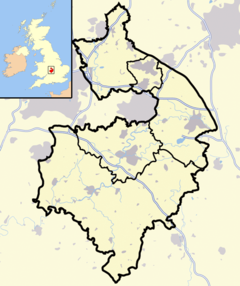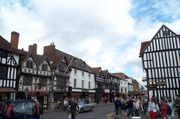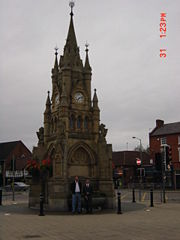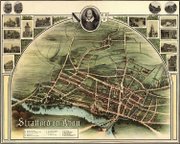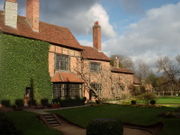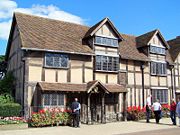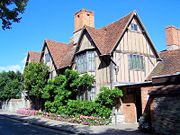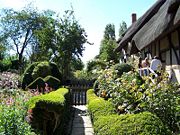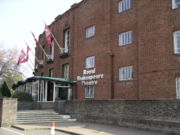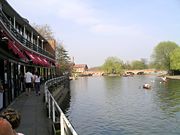Stratford-upon-Avon
2008/9 Schools Wikipedia Selection. Related subjects: Geography of Great Britain
| Stratford-upon-Avon | |
|
Stratford-upon-Avon shown within Warwickshire |
|
| Population | 23,676 |
|---|---|
| OS grid reference | |
| District | Stratford-on-Avon |
| Shire county | Warwickshire |
| Region | West Midlands |
| Constituent country | England |
| Sovereign state | United Kingdom |
| Post town | STRATFORD-UPON-AVON |
| Postcode district | CV37 |
| Dialling code | 01789 |
| Police | Warwickshire |
| Fire | Warwickshire |
| Ambulance | West Midlands |
| European Parliament | West Midlands |
| UK Parliament | Stratford-on-Avon |
| List of places: UK • England • Warwickshire | |
Coordinates:
Stratford-upon-Avon (IPA: /ˌstrætfɚd əpɒn ˈɛɪvən/) is a market town and civil parish in south Warwickshire, England. It lies on the River Avon, 22 miles (35 km) south east of Birmingham and 8 miles (13 km) south west of the county town, Warwick. It is the main town of the District of Stratford-on-Avon, which uses the term "on" to indicate that it covers a much larger area than the town itself. In 2001, the town's population was 23,676.
The town is a popular tourist destination owing to its status as birthplace of the playwright and poet William Shakespeare, receiving about three million visitors a year from all over the world.
The administrative body for the town is the Stratford-upon-Avon Town Council, which is based at the Civic Hall in Rother Street (not to be confused with the Stratford-on-Avon District Council, which is based at Elizabeth House, Church Street). The Town Council is responsible for crime prevention, cemeteries, public conveniences, litter, river moorings, parks, and grants via the Town Trust, plus the selection of the town's mayor. Locally, the town is known simply as Stratford, and as such can be confused with the Stratford in the London Borough of Newham.
Economy
Apart from tourism, which is a huge employer, especially in the hotel and catering sectors, other industries in the town (which included Flowers Brewery, canning, and the manufacture of aluminium ware until these closed in the 1960s and the early 21st century) are boat building and maintenance, mechanical and electrical engineering, food manufacture, IT, and call centre activities (both of which are growing sectors), a large motor sales sector, industrial plant hire, building suppliers, market gardening, farming, storage and transport logistics, finance and insurance, and a large retail sector. Major employers in the town include the NFU Mutual Insurance Company (and Avon Insurance), AMEC, Tesco, Morrisons, Marks & Spencer, Debenhams and B & Q. There are, nominally, three theatres run by the prestigious Royal Shakespeare Company, which attract huge audiences and income for the town.
History and Geography
Stratford has Anglo-Saxon origins, and grew up as a market town in medieval times. The name is a fusion of the Old English strǣt, meaning "street", and ford.
Stratford is also close to the Cotswolds, with Chipping Campden 10 miles (16 km) to the south. As a major sheep producing area (William Shakespeare's father, John Shakespeare, bought and sold sheep's wool illegally) the Cotswolds, up until the latter part of the 19th century, regarded Stratford as one of its main centres for the slaughter, marketing, and distribution of sheep and wool. As a consequence Stratford also became a centre for tanning during the 15th–17th centuries.
Should a mass German invasion have occurred during World War II, the city was to become the temporary seat of Parliament, and host many state servants.
Theatres
The first real theatre in Stratford was a temporary wooden affair built in 1769 by the actor David Garrick for his Jubilee Celebrations of that year to mark Shakespeare's birthday. The theatre, built not far from the site of the present Royal Shakespeare Theatre, was almost washed away in two days of torrential rain that resulted in terrible flooding.
A small theatre known as The Royal Shakespeare Rooms was built in the gardens of Shakespeare's New Place home in the early 19th century but became derelict by the 1860s.
To celebrate Shakespeare's 300th birthday in 1864 the brewer, Charles Edward Flower, instigated the building of a temporary wooden theatre, known as the Tercentenary Theatre, which was built in a part of the brewer's large gardens on what is today the site of the new, and temporary, Courtyard Theatre. After three months the Tercentenary Theatre was dismantled, with the timber used for house building purposes.
In the early 1870s Charles Flower gave several acres of riverside land to the local council on the understanding that a permanent theatre be built in honour of Shakespeare's memory, and by 1879 the first Shakespeare Memorial Theatre had been completed. It proved to be a huge success, and by the early 20th century was effectively being run by the actor/manager Frank Benson, later Sir Frank Benson.
The theatre burned down in 1926, with the then artistic director, William Bridges-Adams, moving all productions to the local cinema.
An architectural competition was arranged to elicit designs for a new theatre, with the winner, English architect Elisabeth Scott, creating what we see on the riverside today. The new theatre, adjoining what was left of the old theatre, was opened by the Prince of Wales, later Edward VIII, in 1932.
The new theatre had many illustrious artistic directors, including the actor Anthony Quayle.
Peter Hall took over the theatre in 1961 (he'd been a director there from 1959), creating the Royal Shakespeare Company (RSC) that same year.
Swan Theatre was created in the 1980s out of the shell of the remains of the original Memorial Theatre, quickly becoming one of the finest acting spaces in the UK.
The Waterside Theatre- the newest, and only privately owned theatre in the town, re-opened in December 2004 after lying empty for approximately ten years. Prior to this the space operated as a automobile garage, a cinema and a visitor attraction (The World of Shakespeare). At present, the theatre houses the Shakespearience visitor attraction, and offers other facilities such as a bar, gift shop and rehearsal spaces.
Travel
Stratford is close to the UK's second largest city, Birmingham, and is easily accessible from junction 15 of the M40 motorway. The 7 miles (11 km) £12 million Stratford Northern Bypass opened in June 1987 as the A422. Stratford-upon-Avon railway station has good rail links from Birmingham ( Snow Hill station, Moor Street station) (hourly trains, until approximately 8:30 p.m.) and from London, with up to seven direct trains a day from London Marylebone.
The Stratford on Avon and Broadway Railway Society aims to re-open the closed railway line from Stratford-upon-Avon to Honeybourne, with a later extension to Broadway, Worcestershire.
The Stratford Upon avon & Midland Junction Railway once ran to Stratford from Blisworth on the L&NWR. Click Here for more information
The town has numerous cycle-paths, and is the terminus of the Stratford-upon-Avon Canal where it meets the Avon. A park and ride scheme was launched in 2006. The Stratford Greenway is a 5 miles (8.0 km) traffic free cycle path, which used to be part of the rail network until the early 1960s and is now part of the Sustrans cycle network (routes NCN5 and NCN41). Starting from town it heads along the River and Racecourse towards Welford and Long Marston with cycle hire available locally.
Coventry is 17 miles (27 km) to the north east, with its new airport a vital European link for business travel, and for tourists.
Tourist attractions
The town is located on the River Avon ("avon" being a Welsh synonym of the English "river"), on the banks of which stands the Royal Shakespeare Theatre (RST) designed by the English architect Elisabeth Scott and completed in 1932, which is the home of the Royal Shakespeare Company. Until recently the RSC also ran two smaller theatres, the Swan, which is modelled on an Elizabethan theatre (closed in August 2007 as part of plans for refurbishment) and The Other Place theatre, a Black box theatre which closed in 2005 to make room for the temporary RSC Courtyard Theatre, which opened in July 2006. This theatre is now the home of the RSC while the RST is being refurbished; its interior is similar to the planned interior of the refurbished RST. The site of The Other Place has now become the foyer, bars, cloakroom, dressing rooms, and rehearsal space of the Courtyard Theatre. The Other Place will be reinstated after the RST and Swan refurbishment is complete in 2010 and the Courtyard Theatre is dismantled, although many in the town would retain the Courtyard so that it can used by local theatre companies.
Other tourist attractions within the town include five houses relating to Shakespeare's life, which are owned and cared for by The Shakespeare Birthplace Trust. These include Hall's Croft (the one-time home of Shakespeare's daughter, Susannah, and her husband Dr. John Hall) and Nash's House,which stands alongside the site of another property, New Place, owned by Shakespeare himself, wherein died. Near to the town are Anne Hathaway's Cottage at Shottery, the home of Shakespeare's wife's family prior to her marriage, and Mary Arden's House, the family home of his mother. Elsewhere in the district are farms and buildings at Snitterfield, that belonged to the family of Shakespeare's father.
The most recent addition to the town is Shakespearience, in the Waterside Theatre. The show takes the story of Shakespeare into the digital age, exploring this life and legacy alongside highlights of his plays using a 21st-Century version of the Victorian stage illusion Pepper's Ghost.
At the top end of Waterside is Holy Trinity Church, where Shakespeare was baptised and is buried.
Non-Shakespearean attractions include the Stratford Butterfly Farm, which is on the eastern side of the river and the Bancroft Gardens.
The influx of tourists into Stratford (3.5 million a year) has caused tension with residents for decades, and there are perennial complaints about numerous tour buses clogging certain roads in the town.
Each year on 12 October (unless this is a Sunday, in which case 11 October) Stratford hosts one of the largest Mop Fairs in the country. Then, on the second Saturday following, the smaller Runaway Mop fair is held.
Henley Street
Henley Street is one of the oldest streets in Stratford-upon-Avon, where, in 1556 John Shakespeare bought a half-timbered farm house that is typical of the Tudor style of architecture of its day, which, in 1564 became the birthplace of his son William Shakespeare. The birthplace now stands alongside the Shakespeare Centre, completed in 1964 and not far from the Carnegie Library, which was completed in 1905. Henley Street is now a major tourist and shopping area for the town, with many pavement cafes and street entertainers.
Sheep Street
As the name suggests Sheep Street, which leads down from the Town Hall to Waterside and the RST, was from early times and until the late 19th century, the area where sheep, brought from the neighbouring Cotswold Hills, were slaughtered and butchered. Today it is the restaurant centre of the town. Sheep Street also has some long established ladies ' gown' shops. The oldest house in Stratford, The Shrieves House, where Oliver Cromwell is thought to have stayed in 1651, before the second battle of Worcester, can be found in this busy street. Alongside, and behind The Shrieves House is the Falstaffs Experience, which is an entertaining museum of the macabre.
Waterside & Southern Lane
This area of Stratford, which runs from the foot of Bridge Street to Holy Trinity Church (and leads directly off Sheep Street and Scholars Lane) runs alongside the River Avon and offers access to the Waterside Theatre and all areas of the RST. The RST is currently undergoing great renovation works, including work to the Bancroft Gardens at the front of the main RST building.
The Bancroft Gardens run from Waterside to the River Avon and include a canal basin. During the summer months there are often street performers performing to the public on the lawns.
In October 2007 the Italian restaurateur and broadcaster Antonio Carluccio opened a new restaurant below the Waterside Theatre (previously Hamiltons restaurant).
Education
Stratford is also home to several institutions set up for the study of Shakespeare, including the Shakespeare Birthplace Trust, which holds books and documents related to the playwright, and the Shakespeare Institute.
A notable school in Stratford is King Edward VI school, which is where William Shakespeare is believed to have studied. It is an all-boys school, and one of the few remaining grammar schools in England, selecting its pupils exclusively using the Eleven plus examination. There is also an all-girls grammar school, Stratford-upon-Avon Grammar School for Girls, colloquially known as 'Shottery School' after its location in the village of Shottery, a short distance from the town centre. Finally, there is a non-selective secondary school, Stratford-upon-Avon High School, formerly known as the Hugh Clopton Secondary Modern School, which was demolished to make way for the new high school. There are no independent secondary schools in the town. There are numerous primary schools in the town, both state and independent, and Stratford-upon-Avon College.
Churches
- Stratford-upon-Avon Holy Trinity Church
Notable people
- William Shakespeare, English playwright and poet.
- Simon Pegg, actor most known from Hot Fuzz and Shaun of the Dead, studied theatre here; (was born in Gloucestershire, UK.)
- Arthur C. Clarke, author of 2001: A Space Odyssey, served with the RAF at Stratford-upon-Avon during the 1940s. Clarke later wrote the short story The Curse, which takes place in a post-apocalyptic Stratford-upon-Avon.
- Former Secretary of State for War John Profumo was the MP for Stratford-upon-Avon in the 1950s.
- From 1901 to 1924, the romantic novelist Marie Corelli, real name Minnie Mackay, daughter of Charles Mackay, made her home, with her companion Miss Vyver, at Mason's Croft, Church Street, Stratford.
- Labour MP and actor Andrew Faulds lived in Old Town, Stratford, until his death in 2000, aged 77.
- English footballer Dion Dublin, who has played for both Manchester United and Aston Villa, and his national team, lives with his wife and family in Stratford.
- Members of indie bands Klaxons and Pull Tiger Tail all grew up and went to schools in Stratford before they moved to New Cross, London.
- David Bradley - actor most notably known for his role as Argus Filch in the very popular book series Harry Potter created by J. K. Rowling and adapted into film by Warner Bros.
- Gordon Ramsay, noted celebrity chef, and star of several cooking related shows, moved to Stratford-Upon-Avon with his family in 1976 when he was ten years old.
Suburbs
Shottery, Bishopton, Bridgetown, Tiddington.
Town twinning
 Stratford, Connecticut
Stratford, Connecticut Stratford, Ontario
Stratford, Ontario Doha, Qatar
Doha, Qatar
